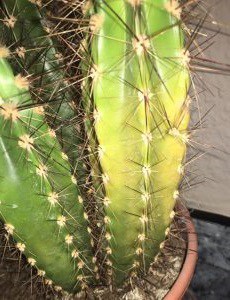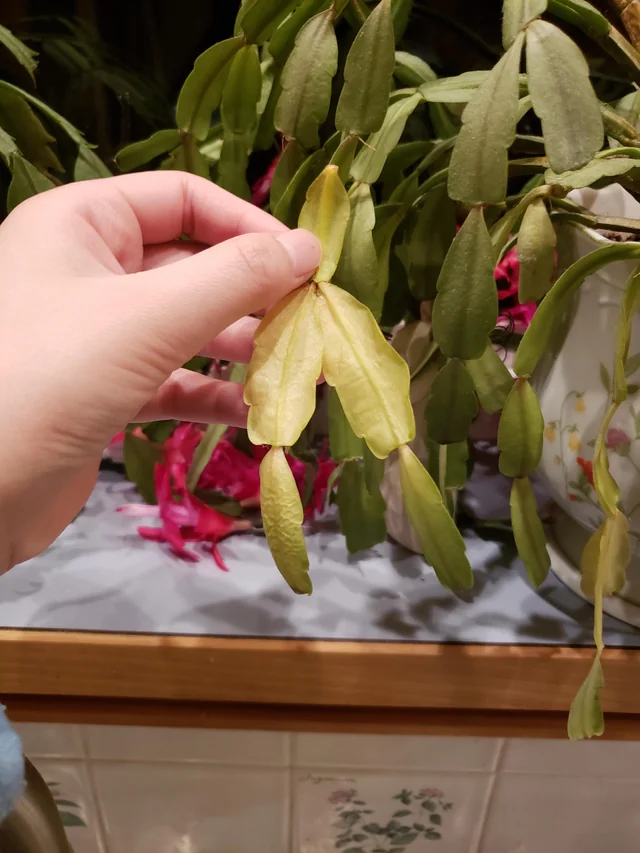Cactus plants are generally known to be indestructible. However, there are a few instances where you would witness your cactus developing specific issues. One such problem that many cactus owners come across is their cactus turning yellow. Have you noticed the leaves and stems of your cactus turning yellow? If you are wondering why that happens, we are here to help you.

The primary reason for the cactus turning yellow is overwatering. Cacti cannot tolerate soil that is consistently damp or wet. When the soil does not dry out between two watering sessions, the cactus can develop roots and rot and can ultimately die off. A few other reasons for the cactus to turn yellow can include too much light or lack of nutrients.
Why is My Cactus Turning Yellow?
There can be several reasons for your cactus to turn yellow. If you notice the yellow tinge starting from the top, it can indicate excessive exposure to sunlight. You can take immediate action to save your plant. In fact, a cactus turning yellow from the top is never a severe concern if you notice it just ahead of time.
However, a cactus turning yellow from the bottom is a serious case and needs action to avoid further damage. The most common cause of this situation is root rot. The yellowing can soon spread to the top and make the plant die soon after.
Let us analyze the top 8 reasons why your cactus is turning yellow:
Lack of enough water
Underwatering can be a concern and can cause the cactus to turn yellow. If you find the cactus turning yellow in summer, it will need a lot of water. However, make sure that the soil is not excessively wet or damp. It can result in causing the exact opposite issue – the root rot.
The quality of water you feed
The quality of the water used for the cactus can also cause it to turn yellow. If your water consists of fluoride and other similar chemicals, they can cause the cactus to turn yellow. Over time, the salts in the water may cause the cactus to turn yellow.
Inadequate light
Cactus are from deserts, and they are accustomed to bright sunlight. The exact amount of light that your cactus requires is dependent on the species. However, providing it with too much light can also be counter-positive. Too much light can cause sunburns and make the plant turn yellow from the top. In any case, it is practical to understand the exact amount of light required by each type of cactus.
There are two key ways you can try finding if your plant receives enough light or not:
- If your plant begins to turn yellow from the top, it may indicate that it is getting too much light. Move it to an area that has moderate exposure to light.
- If the plant tends to grow towards the window or towards a source of light, it is indicative of the fact that the plant is not getting enough light.
Type of the soil
Cacti typically need soils that drain. Heavier soil, such as clay soil, may leave the plant retaining too much water and thus set in root rot. As the roots begin to rot, the plant fails to supply enough nutrients to the top, and subsequently, the plant begins to turn yellow.
Temperature issues
The climate in the deserts is too hot during the day and freezing cold at night. Since the cacti are used to grow in the desert climate, you will need to replicate these conditions at home. Some plants, like Christmas cactus and Jade, need a cold climate at night to grow better. That is perhaps why Jade and Christmas cactus grow and blooms in the winter.
Bug infestation
A few of the bugs that you would find affecting the cactus family would include scale insects, mealy bugs, spider mites, slugs, or snails. They stick to the stem of the plant and keep sucking the plant juices. This can make the plant turn yellow.
Lack of Nutrients
Cacti, like any other plant – require nutrients to thrive and grow. Lack of proper nutrients may be one of the reasons why your cactus is turning yellow. Once again, this can possibly be due to root rot. It is also possible that the soil and the fertilizer may not have enough nutrients.
Check your roots for any signs of rotting. Cut off the rotten parts, and change the soil immediately. The roots may begin regrowing if you are lucky.
Size of the pot
Pots may also prove to be a reason for the cactus turning yellow. Your plant will not grow as expected if the pot size is inadequate. If the pot does not drain the water, it can set in root rot issues and can make your cactus turn yellow. A large pot tends to retain water and can keep the soil wet.
Is a Cactus Dead If It Turns Yellow?
A cactus turning yellow can be because of stress. But it does not mean that the cactus is dead. At least not as yet. You can save a cactus that is turning yellow by taking a few actions. The yellow color simply indicates that the plant is being either overwatered or underwatered.
If the cactus is just at a stage where the yellowing has just set in, you can save the plant by employing a few proactive steps. Except when there is excessive root rot, the cactus turning yellow should not leave it dead. You can always revive it by following proper steps to alleviate the reasons that cause the yellow tinge.
How Do You Fix the Christmas Cactus Turning Yellow?
Christmas cactus turning yellow has the same reasons as the yellowing on any other cactus. The primary reasons that can cause the Christmas cactus to turn yellow include improper light, not enough moisture, poor drainage, lack of nutrients, and pest infestation.

The Christmas cactus changing color can have any one or a combination of the following reasons:
- No proper light: Christmas cactus needs indirect light. If it is getting too much light, it may begin turning yellow. The Christmas cactus is a tropical cactus, and it does not tolerate direct sunlight. Place the cactus near a north- or west-facing window.
- Improper moisture: The cactus plant may turn yellow due to both overwatering and underwatering. Striking the right balance is a tough choice, and that is what makes it a tricky question to answer.
- No proper drainage: The cactus does not like the wet soil, and this can lead to root rot. Always use a pot that offers proper drainage. Make sure your pot has at least one hole. Add up elements such as fine gravel, pumice, or sand for proper aeration and drainage.
- Deficiency of nutrients: If you have been providing the proper nutrients to the plants, you are likely to get the best results. Use a suitable potting medium, and opt for periodic feeding.
- Pests and diseases: The Christmas cactus turning yellow can also be due to the pest infestation. Some of the pests can include aphids, mealybugs, red spider mites, soft brown scales, thrips, and whiteflies, as well as soil-borne fungus gnats.
What Causes The Moon Cactus To Turn Yellow?
Like many other cacti, the Moon cactus also turns yellow if it receives a lot of water and moisture. Overwatering can cause the Moon cactus to develop root rot. The roots can turn mushy and turn yellow. This will further spread up and damage the entire plant.
Some reasons that Moon cacti can turn yellow include:
- Proper watering: Moon cactus requires a minimal amount of water, and an improper balance of water can set in issues and turn the cactus yellow.
- Not enough light: Moon cactus requires bright and indirect sunlight. Make sure to avoid direct sunlight.
- Small pot: If the pot is too small, it can hinder the growth of the roots properly. This can turn the moon cactus yellow.
- Pest infestation: The pest and bug infestation can be yet another reason that can turn moon cactus to turn yellow.
The Concluding Thoughts
Well, cactus turning yellow can be due to various reasons. If you find your cactus turning yellow, make sure to notice the exact changes and causes. You may need to have a close look at all the symptoms before arriving at the specific reason that might have turned your cactus yellow.
We assume the tips shared above should ideally help you arrive at the best solutions. Follow them and share your experiences with us to help our fellow succulent lovers.
